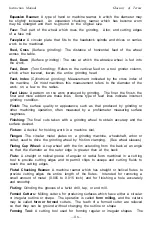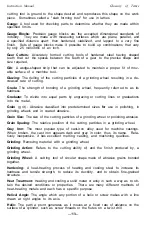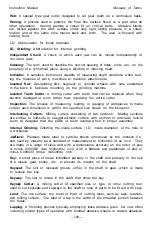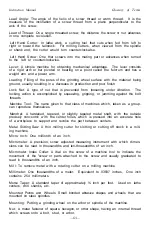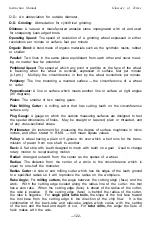
Instruction Manual Glossary of Terms
such as the hardness or toughness of metals being cut On lathe cutting tools, the
rake angles (top and side) are located on the top of the tool bit. The rake angle is
positive
if the face slopes downward from the point toward the shank and
negative
if the face slopes upward toward the shank
Backing Off:
A shop term meaning to put a relief or clearance land on a cutter
back of the cutting edge or the primary relief land.
Backlash:
Lost motion (play) in moving parts, such as thread in a nut or in the
teeth of meshing gears.
Balance:
(dynamic) A piece in static balance is in dynamic balance, if, upon rotat
ing, there is no vibration nor "whip" action due to unequal distribution of its weight
throughout its length.
Balance:
(static) A grinding wheel is in static balance when, centered on a fric-
tionless horizontal arbor, it remains at rest in any position
Balancing:
Testing for balance, adding or subtracting weight to put a piece into
either static or dynamic balance.
Ball Bearing:
An antifriction bearing having an inner race which fits on a shaft and
an outer race which fits into a housing or support. Hardened steel balls are used
between inner and outer races to reduce friction.
Bearing:
Point of support. The part of a machine in which the spindle revolves.
Bed:
One of the principal parts of a machine tool, having accurately machined ways
or bearing surfaces for supporting and aligning other movable parts of the machine.
Bevel:
The angle formed by a line or a surface that is not at right angles to another
line or surface.
Blotter:
A disc of compressible material, usually of blotting paper stock, used be
tween a wheel and flanges when mounting.
Bond:
The material in a grinding wheel which holds the abrasive grains together
and supports them while they cut.
Bore:
The inside diameter of a cylinder, or a hole for a shaft. Also, the operation
of machining a circular hole in a metal workpiece.
Brass:
An alloy of copper, tin, and lead.
Brazing:
The joining of metals by the use of an alloy consisting of nonferrous metals
having a melting point below that of the metals to be brazed. Brass and copper
together with a suitable flux such as borax are often used.
Brinnell Hardness Tester:
A machine used for testing hardness by indentation of
metals, except very hard ones like tool steels.
Brittleness:
In some respects the opposite of toughness. The characteristics that
cause metal to break easily.
Broach:
A long tool on which the cutting teeth increase slightly in size with each
succeeding tooth, and which is pushed or pulled through a hole or across a surface
to form the desired shape and size.
Bronze:
An alloy of copper and tin
Brown and Sharpe Taper:
A commonly used standard taper for shanks or arbors of
milling machine tools and cutters.
—114—



















